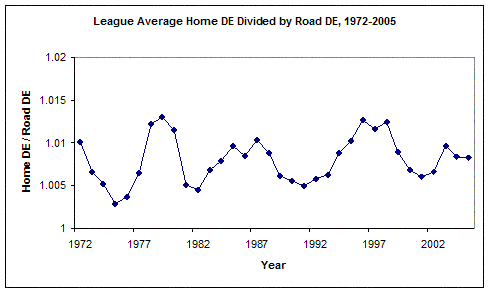BP Comment Quick Links

 | |
November 3, 2005 Crooked NumbersHomeland Defense
Because I've been lazy and haven't turned Park Adjusted Defensive Efficiency (PADE) into a regular stat report yet, I was recently running the end of season numbers for a few readers and fellow authors who were curious how things shook out. Before we get going any further, here they are. PADE is expressed as a percentage, so a PADE of 1.00 means the team turned 1% more balls in play into outs than a league average defense given their park.
While there's certainly a great deal of discussion to be garnered from that list, there's one point in particular that I would like to address, something that definitely should have struck me a long time ago. When looking at all the numbers in the PADE column, interestingly, they lean a bit on the negative side. The White Sox led the league with a 2.70, but there were three teams below the opposite of that: the Marlins, Reds, and Royals. (The Yankees, who started the year off on pace for one of the worst marks of all time, realigned their defense and managed to climb back to the middle of the pack.) Overall, the average PADE in 2005 was -0.40. While it would be fun to say that that number is the result of teams playing particularly terrible defense in 2005 (and insert old curmudgeonly remarks about the "old days"), that's not the case; PADE is adjusted for the league average in each season. The only number involved in the computation that's not from the single season is each of the park factors. Thus, it's possible that the park factors are somehow too high, meaning we assume it's easier to play defense than it really is because of higher park factors in previous seasons. (I would assume that turnover in ballparks would be the true culprit, but there hasn't been enough turnover in parks in the last three seasons to drag the average down that far.) When averaging the park factors for 2005, we get 1.0087; all things being equal, the average park factor should be 1. As such, the park factors are a little high and are therefore driving the final PADE numbers below 0.00 on average. But why is that? The park factors used for PADE are each team's defensive efficiency at home divided by its defensive efficiency on the road. There's an argument to be made that using a team and their opponent's stats--as most park factors are computed--would be better, but not doing so has highlighted an interesting fact. Here's how each team's DE at home divided by their DE on the road looks from 1972-2005:  The trend of the line isn't important; the range and scale of the Y-axis, however, is important. Never in the last 34 seasons have teams played better defense on the road as they have at home; in fact, teams have been trending towards higher numbers, meaning the difference in defensive performance at home and on the road is growing. This is why the park factors in PADE always average out to higher than 1 and why overall, PADE tends to be on the negative side. With regards to PADE, it's easy to adjust for this by both adding opponents' stats to the park factors and centering the metric around 0 for each year (essentially adding -0.40 to all scores this year). But the fact that the league as a whole tends to play better defense at home than on the road--as measured by DE--brings up the age-old question of home field advantage. This issue has been covered before, both here and elsewhere, and the general conclusion is that the home team performs slightly better in most measures of performance, but the reason behind that advantage is still unknown. I'm not going to dispute that, but the fact that teams play better defense at home is likely the cause of knowing the park better. We're not talking about cutting off doubles in the gap, turning triples into doubles, or turning double plays, but rather smaller advantages like knowing the foul ground better, the outfield dimensions, the cut of the infield grass. These are all hypothetical reasons for the difference and so we must concede that there is no way to determine the why at this point. How much of a difference does a 1% advantage on defense at home make? In 2005, the league average defense posted a DE of .6947 overall with a mark of .6975 at home and .6919 on the road. If we assume that teams post identical rates of singles, doubles, and triples against home teams and road teams and that all other factors are equal, a team that posts a .6975 DE saves about 13 runs in 81 games over a team that posts a .6919 DE. Over 81 games, that works out to about 1.3 games, or about a .508 winning percentage. Thus, about 20-25% of the typical .530-.540 home field advantage appears to be the result of turning balls in play into outs at a higher rate at home than on the road. As mentioned above, that result is more "how" than "why," but for whatever reason, teams have consistently higher defensive efficiencies at home than on the road, a fact that accounts for a significant portion of the home field advantage inherent in baseball. With regards to PADE, it will likely undergo an adjustment in the calculation of the park factors or a league-wide adjustment to center the scale around zero. And, eventually, I'll get that into a regular stat report. Really. I swear.
|